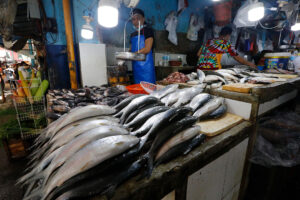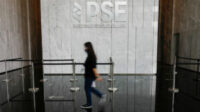[ad_1]

By Keisha B. Ta-asan, Reporter
THE PHILIPPINE central bank kept its benchmark interest rate — as expected — at a near 17-year high for a third straight meeting on Thursday, as policy makers remained watchful despite easing consumer prices.
The Bangko Sentral ng Pilipinas (BSP) left the target reverse repurchase rate (RRP) at 6.5% at its first policy meeting of the year, as predicted by 15 of 17 economists in a BusinessWorld poll last week. Interest rates on the overnight deposit and lending facilities were also left unchanged at 6% and 7%.
This was the third straight meeting that the BSP stood pat since its 25-basis-point off-cycle increase on Oct. 26, 2023. It raised borrowing costs by 450 basis points (bps) from May 2022 to October 2023.
“In consideration of the prevailing risks, the Monetary Board deems it appropriate to keep the BSP’s monetary policy settings unchanged in the near term amid the improvement in inflation conditions,” central bank Governor Eli M. Remolona, Jr. said in a statement.
“The BSP remains ready to adjust its monetary policy settings as necessary in keeping with its primary mandate to safeguard price stability,” he added.
The central bank lowered its risk-adjusted inflation forecast for 2024 to 3.9% from 4.2%, but raised its view for 2025 to 3.5% from 3.4%. It also lowered its baseline inflation forecast for this year to 3.6% from 3.7%, but kept its projection for next year at 3.2%.
Risks to the inflation outlook might have subsided, but risks are still on the upside, Mr. Remolona said.
“The upside risks to the inflation forecasts are linked mainly to higher transport charges, increased electricity rates, higher oil and domestic food prices and the additional impact on food prices of a strong El Niño episode,” he added.
Inflation slowed to 2.8% in January from 3.9% in December and 8.7% a year ago, the slowest since 2.3% in October 2020. It was the second straight month that inflation was within BSP’s 2-4% target.
Mr. Remolona said the recent agreement with Vietnam to secure rice supply in the next five years is encouraging. Efforts to increase rice productivity, including the distribution of drought-resistant seeds, are a step in the right direction, he added.
In January, rice inflation quickened to 22.6% from 19.6% in December, the fastest in nearly 15 years. Rice was also the most significant contributor to December inflation, adding 1.3 percentage points. The commodity had the biggest weight in the CPI basket at 8.87%.
Under a deal signed during President Ferdinand R. Marcos, Jr.’s two-day state visit to Vietnam in January, Hanoi committed to supply 1.5 million to 2 million metric tons of white rice to the Philippines “at a competitive and affordable price” for five years.
MIDYEAR CUT
BSP Senior Assistant Governor Iluminada T. Sicat said there is “scope for a rate cut” this year as soon as they see a firmer inflation downtrend.
“While we see some improvement in headline and core, we still consider taking a more prudent monetary policy stance at this moment,” she told a news briefing.
She noted that inflation might continue to ease this quarter due to base effects, but it might pick up above the 2-4% target in the second quarter. Inflation will go back to the target in the second half, Ms. Sicat said.
She also said higher-than-expected minimum wage increases in the Philippines could reverse slowing inflation.
The Philippine Senate on Wednesday approved on second reading a bill calling for a P100 ($1.78) across-the-board minimum wage increase for workers in the private sector. The Senate president expects the bill to be approved on third and final reading next week.
“We need to maintain our hawkish position but in terms of tone, it’s not as strong as what we had last December. But we continue to be hawkish looking at developments here and abroad,” Ms. Sicat said.
There is still a more than 50% probability of above-target inflation this year, said Dennis D. Lapid, officer-in-charge of the BSP Department of Economic Research.
Ms. Sicat also said the timing of reserve requirement ratio (RRR) cuts should be considered once inflation risks ebb “The BSP continues to maintain its commitment to reduce the RRR level at the rate of its neighbors.”
The central bank said the government might miss its 6.5-7.5% economic growth target this year “as the full impact of the BSP’s prior monetary policy tightening continues to manifest [itself].”
“There could be some moderation in economic activity, but we think that we will still pose modest economic growth for 2024,” Ms. Sicat said.
Finance Secretary Ralph G. Recto earlier said macroeconomic assumptions might need to be adjusted to be “more realistic.”
The economy grew by 5.6% last year, slower than 7.6% in 2022 and falling short of the state’s 6-7% goal.
Capital Economics Senior Asia Economist Gareth Leather in a note said the central bank might start easing policy rates by the middle of the year because inflation is expected to remain within target in the coming months.
“Overall, we expect the BSP to cut rates in May and lower borrowing costs by a total of 200 bps next year, which is much more dovish than the consensus,” he said.
Nicholas Antonio T. Mapa, senior economist at ING Bank N.V. Manila, said BSP would likely remain hawkish and keep rates untouched until the Fed delivers its own rate cuts. “However, with the risk-adjusted inflation forecast already within target, we believe the BSP now has scope to discuss potential easing possibly as early as midyear.”
Pantheon Macroeconomics Chief Emerging Asia Economist Miguel Chanco expects the central bank to cut rates by 100 bps this year starting May.
“Our base case is that growth will soften further this year to 4.8% from 5.6% in 2023, which would represent the weakest full-year outturn since 2011, barring the pandemic-induced recession in 2020,” he said.
Makoto Tsuchiya, an economist from Oxford Economics, said the Philippine central bank would cut rates when it starts to see a “firmer indication of disinflation.” “For the time being, risks are tilted to slower commencement of rate cuts given inflationary risks including weather disruptions, geopolitical tensions and possible minimum wage hikes.”
[ad_2]







